Bibisara Assaubayeva made her first draw in New Delhi but is still in the lead with 4,5 points. The race for the top is heating up as both Lagno and Goryachkina scored
Round 7 saw two decisive outcomes and two draws. It was a relatively short round, with the last game finishing after three and a half hours of play.
Round 7 results:
Nana Dzagnidze – Kateryna Lagno, 0 – 1
Bibisara Assaubayeva – Humpy Koneru, ½ – ½
Vaishali Rameshbabu – Harika Dronavalli – ½ – ½
Nino Batsiashvili – Aleksandra Goryachkina – 0 – 1
In the seventh round of the Women’s Grand Prix in New Delhi, Bibisara Assaubayeva made her first draw of the event against Humpy Koneru, playing the Reversed Benoni. Although Assaubayeva had a better position, she couldn’t find a path to victory. Despite this, the player from Kazakhstan still leads the tournament with 4,5 out of 6 points. Koneru has three points.
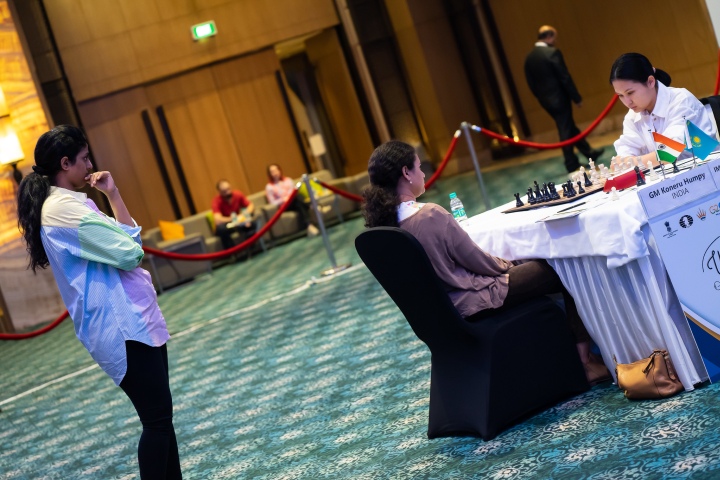
Meanwhile, Aleksandra Goryachkina took another step towards the top, capitalizing on a blunder by Nino Batsiashvili in Veresov. Kateryna Lagno also had a successful match against Nana Dzagnidze, taking advantage of Nana’s misplay in the Bogo-Indian to secure a win. Lagno and Goryachkina both have 3,5 points, but Goryachkina has one game more.
The Indian derby between Harika Dronavalli and Vaishali Rameshbaby, ended in a draw. Vaishali has 1,5 points while Harika has two.
Here follows a more detailed look at the games of Round Seven in the Women’s Grand Prix:
Nana Dzagnidze – Kateryna Lagno
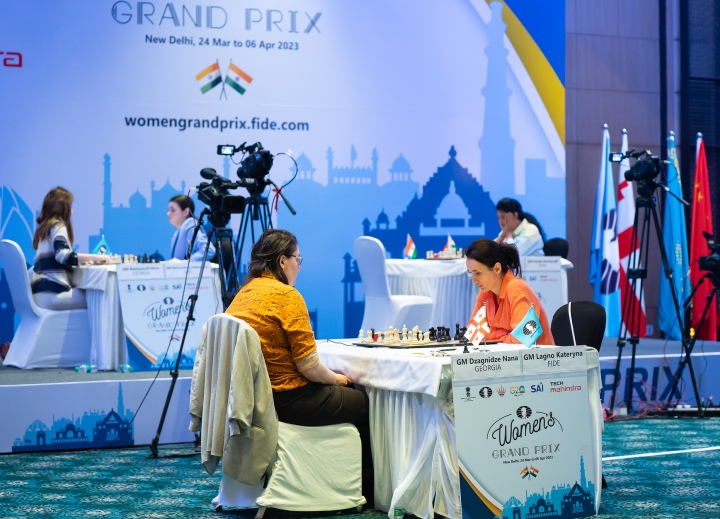
In the huge number of games the two have played, Lagno leads by a significant margin.
Nana forgot her moves in the opening and spent a lot of time in a rare line of the Bogo-Indian. Kateryna sacrificed a pawn early on and got some compensation but hardly more. On her fourteenth move, however, Dzagnidze made a serious mistake.
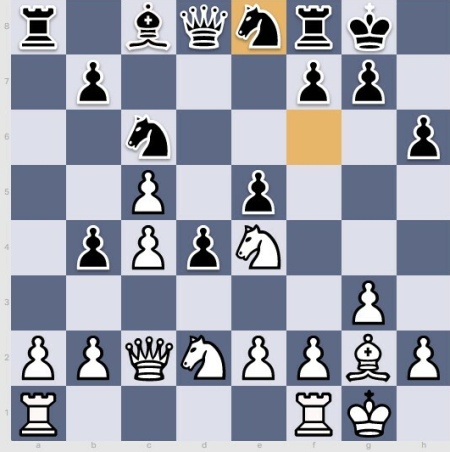
Here White should play 14.a3, but Nana forgot the line and played 14.f4? allowing Black to create a strong pawn centre and obtain a serious space advantage, which Kateryna used to align her pieces for the attack.
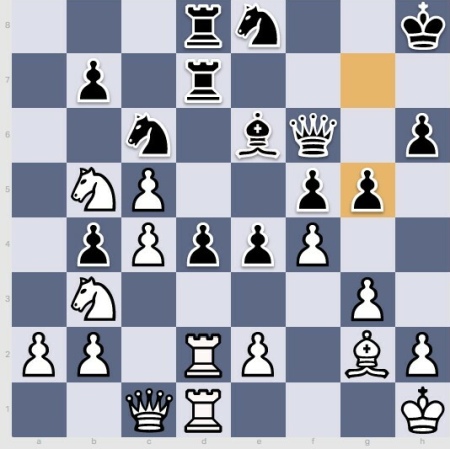
After due preparation, Black started her onslaught on the white king. Nana had just one way to stay in the game for a while by putting her rook on f1, to protect and control the f4 square. Instead, she played 23.Qc2?, allowing Black to open the g-file with deadly threats.
23…gxf4 24.gxf4 Qh4 – White has no escape. The final portion of the game turned into a hunt for the White’s king that ended on move 29. Leaving the playing hall, Nana Dzagnidze briefly commented that “one can’t play when they forget or don’t know the lines”. Despite a challenging tournament, Nana Dzagnidze is maintaining a courageous demeanour and refraining from displaying any overtly negative emotions.
Lagno now has four points, while Dzagnidze is on two.
Bibisara Assaubayeva – Humpy Koneru
This was the first classical game between Assaubayeva and Koneru. So far, they have played 23 Blitz games with an even head-to-head record.
Just like in the encounter between Assaubayeva and Dronavalli, the game saw the Reversed Benoni and, again, White emerged clearly better in the opening.
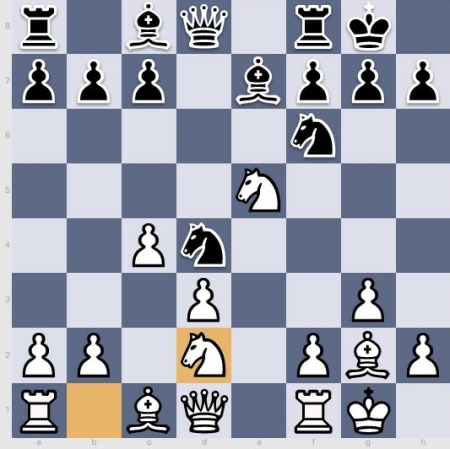
In the post-game analysis, Koneru explained that here she misplayed the line – she should have continued with 10…c6 but played 10…Re8. Bibisara had an extra pawn with no visible compensation for Black.
On move 16, White had a chance to increase her advantage by grabbing the b7-pawn but Assaubayeva opted for a safer approach.
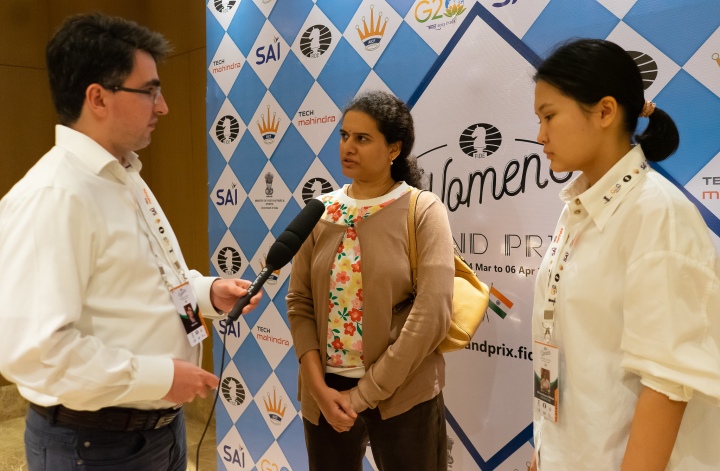
Little by little, Koneru coordinated her pieces and countered by pushing the a-pawn and then activating her kingside pieces, to force exchanges and blunt White’s edge.
Despite not finding the best moves, White had a better position for most of the game, although to Koneru’s credit, she put up a stubborn resistance. In the end, as both reached time trouble, it all turned around as Assaubayeva handed her advantage to Black. Sensing the moment, Assaubayeva made a good practical decision by offering a draw in the following position after 37.f3
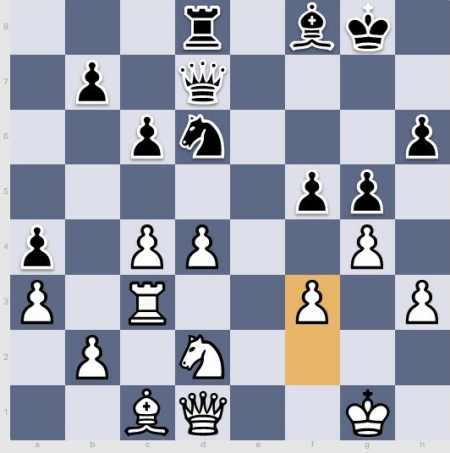
Koneru was better here: Black just needs to realign her heavy pieces on the kingside and put pressure on White’s centre. However, Humpy was not in the mood to continue, and the two agreed to split a point.
This is the first draw for Bibisara Assaubayeva who now has 4,5 points out of six games. Humpy Koneru has three points.
Vaishali Rameshbabu – Harika Dronavalli
In the Indian duel between Vaishali and Harika, out of 17 games played between the two, Vaishali won nine, and Harika won eight.
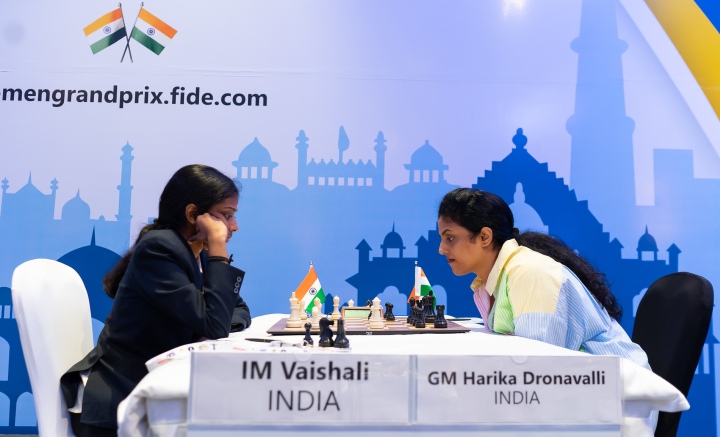
In the Open variation of the Ruy Lopez, the opponents tested a rare line and quickly stepped off the beaten track. Both played quite logical natural moves keeping position in balance. Following exchanges and simplifications, the two reached an even rook endgame and called it a day.
Dronavalli is on two points while Rameshbaby is on 1,5.
Nino Batsiashvili – Aleksandra Goryachkina
Out of the total of 13 games the two have played so far, Nino has two wins and Goryachkina has four.
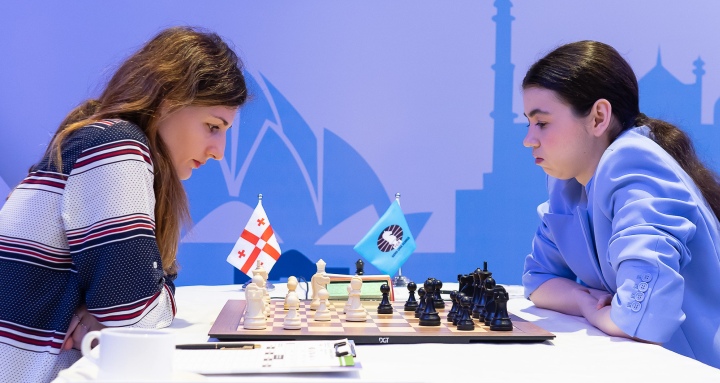
In the Veresov with 3.Bf4, the two entered unchartered waters as early as move six. Batsiashvili went for an unusual move 6.Nh3 but after natural 6…Bb4 played by Goryachkina, Black was already slightly better. A more logical move was 6.h4, heading into a sharp position.
After Nino closed the centre on move eight, Aleksandra got a very good version of advanced Karo-Cann with a couple of White’s pieces misplaced.
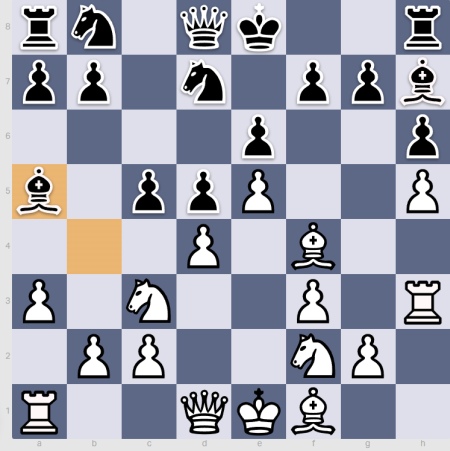
White’s uncastled king is exposed, and the centre is hanging by a thread. White should have proceeded with 13.dxc5 to remove the c5 pawn, countering Black on the left flank and centre. Instead, 13.b4 played in the game was premature and, costly.
After the game, Nino explained that the occasional noise coming from another part of the hotel affected her concentration, and she misplayed.
After 13…cxb4, instead of taking 14.axb4 and continuing resistance in a worse position, Nino played 14.Nb5? – a well-known idea in the French Defence, that just doesn’t work here.
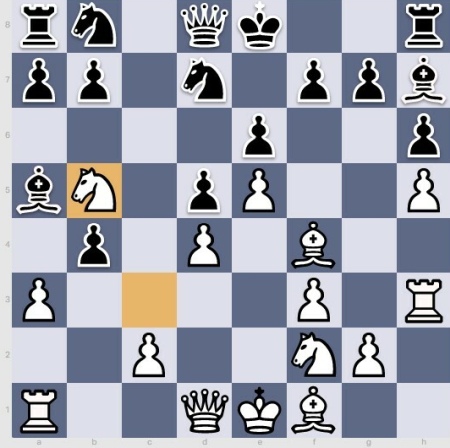
It failed to 14…Bxc2! 15.Qxc2 b3+ 16.Qd2 Bxd2 17.Bxd2 Aleksandra Goryachkina traded in two bishops for a queen and two pawns.
The rest was unnecessary. Batsiashvili continued to struggle but quickly realized the futility of her attempts.
Standings after Round 7:
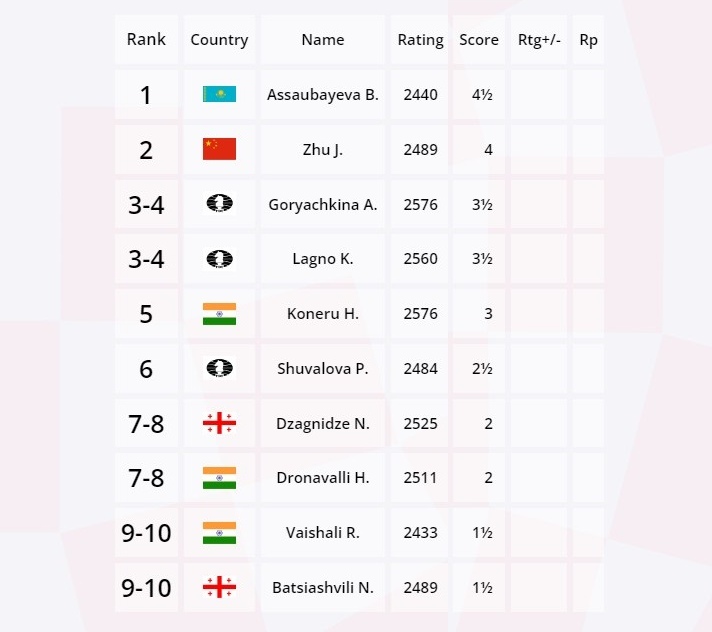
The eighth round of the third leg of the Women’s Grand Prix will take place on Sunday, 2nd April at 3 PM local time.
Round 8 pairings:
Kateryna Lagno – Aleksandra Goryachkina
Harika Dronavalli – Nino Batsiashvili
Polina Shuvalova – Vaishali Ramehsbabu
Zhu Jiner – Bibisara Assaubayeva
Nana Dzagnidze and Humpy Koneru have a rest day.
Text: Milan Dinic
Photo: Ismael Nieto
About the Women’s Grand Prix
The FIDE Women’s Grand Prix consists of four tournaments played between September 2022 and May 2023 and includes 16 women players who take part in three of the four tournaments. The two players who score the greatest number of cumulative points in the series shall qualify for the FIDE Women Candidates Tournament 2023-24.
The players participating in the Women’s Grand Prix have been selected based on their performance in key FIDE events and their ELO. Also, each of the four local tournament organisers has a right to nominate a player of their choice.
The time control for the tournament is 90 minutes for the first 40 moves, followed by 30 minutes for the rest of the game with an increment of 30 seconds per move starting from move one.
The total prize fund for each one of the four events is €80,000, with another €80,000 being distributed among the top eight players in the overall standings for the Grand Prix series.
General information about the venue and the dates
The third leg of the Women’s Grand Prix will take place in New Delhi’s Leela Ambience Convention Hotel. The five-star hotel is designed to cater to business events and large meetings and should make an ideal place for a tournament of this level.
The rounds will be played each day from 3 PM local time (9.30 GMT).
For more information about the event, visit https://womengrandprix.fide.com/.







